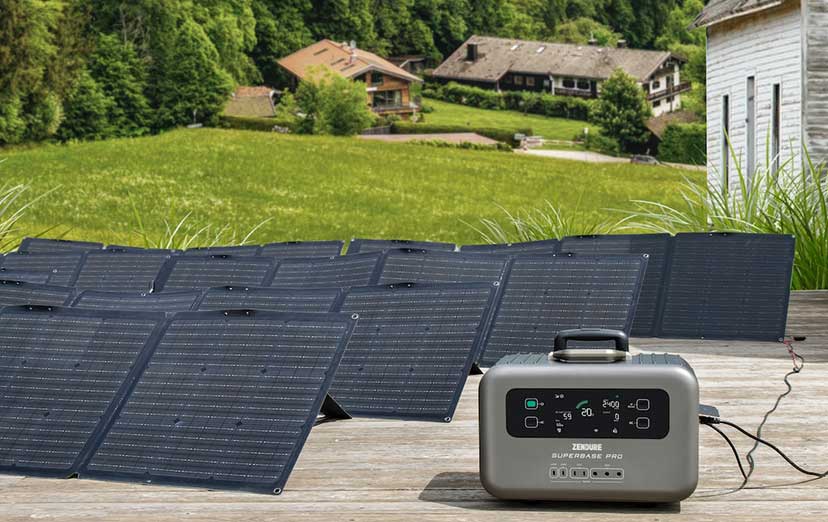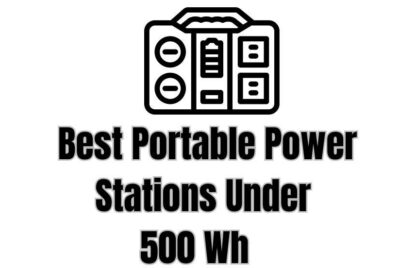Portable Power Stations- A Complete Run Down
I may earn a commission for purchases made through my links. It helps me run this site. Check out my disclosure for more details.
Hello there, adventurers and technophiles! Whether you’re planning your next camping trip or just want to ensure you’re prepared for a possible power outage, portable power stations can be your trusty ally. I’ve noticed quite a few questions popping up around these nifty gadgets, so let’s dive right in and demystify these power-packed beasts.
Introduction
Portable power stations, which can also be termed solar generators or battery generators, are devices that store energy in a battery and convert it to usable power for a variety of devices and appliances. They are typically used in situations where grid power is unavailable or unreliable, such as camping trips, outdoor events, and emergency situations.
A portable power station, often known as a portable generator or a battery-powered inverter, is a rechargeable battery-powered device capable of powering various electrical devices. It’s like a portable slice of your home’s power grid that you can carry wherever you go. These stations usually come with AC outlets, DC carport (connect to cigarette lighter), and USB charging outlets, to cover a variety of power needs.
How Do Portable Power Stations Work?
Portable power stations work by storing electrical energy in a large battery. This stored energy is then converted into a form that your devices can use (like AC power for your laptop or DC for your car charger). They can be charged via several methods: from a wall socket at home, your car’s 12V socket, or even solar panels, which are perfect for long trips away from power sources.
Benefits of Portable Power Stations
Portable power stations offer several benefits over traditional generators and other power sources. They are:
- Quiet: Unlike gas-powered generators, portable power stations run silently, making them ideal for use in quiet environments like campsites or residential areas.
- Clean: Portable power stations produce no emissions, making them environmentally friendly and safe to use indoors.
- Convenient: Portable power stations are compact and lightweight, making them easy to transport and store.
- Versatile: Portable power stations can power a variety of devices and appliances, including smartphones, laptops, refrigerators, and even power tools.
When choosing a portable power station, there are several factors to consider, including battery capacity, power output, weight, and portability.
Battery Capacity
Battery capacity refers to the amount of energy a portable power station can store. This is typically measured in watt-hours (Wh) or amp-hours (Ah). The higher the battery capacity, the longer the power station can run without needing to be recharged.
Power Output
Power output refers to the amount of power a portable power station can deliver at once. This is typically measured in watts (W) or kilowatts (kW). The higher the power output, the more devices and appliances the power station can power simultaneously.
Weight and Portability
Portable power stations come in a range of sizes and weights, from small, lightweight models to larger, heavier ones. When choosing a portable power station, it’s important to consider how you’ll be using it and how easy it will be to transport.
Inverter Type
Portable power stations use inverters to convert DC power to AC power.
There are two main types of inverters: you can have either a pure sine wave inverter or a modified sine wave inverter.
Pure sine wave inverters provide a clean and stable power output that is similar to grid power.
Modified sine wave inverters provide a less stable and less clean power output that may cause issues with some sensitive electronics.
Battery Chemistry
- Portable power stations use lithium-ion batteries.
- There are several types of lithium-ion batteries, including lithium iron phosphate (LiFePO4), lithium nickel manganese cobalt oxide (NMC), and lithium polymer (LiPo).
- Each type has its own advantages and disadvantages in terms of energy density, lifespan, and safety.
Safety Features
- Portable power stations have safety features to prevent damage to the battery and ensure safe operation.
- Common safety features include overcharge protection, overdischarge protection, short circuit protection, and overcurrent protection.
Charging Options
Portable power stations can be charged a lot of ways, there’s the grid with traditional AC wall outlets, which still remains the fastest way to recharge, then for the more environmentally focused among us theres solar panels, the more and larger you have the faster you can recharge your batteries. Car chargers are another option.
For the best of all world’s, some models even allow for multiple charging options, giving you more flexibility in how you recharge the device.
Display and Control Panel
Many portable power stations come with a display and control panel that allows you to monitor battery level, power output, and other important information. This can be especially useful when using the device for extended periods of time or in emergency situations.
Safety Features
Portable power stations often come with built-in safety features, such as overcharge protection, short circuit protection, and overheat protection. These features help prevent damage to the device and ensure safe operation.
Where Can You Use Portable Power Stations?
Portable power stations can be used in a variety of situations, including the following.
Camping and Outdoor Activities
Portable power stations can living up your camping experiences by letting you run all your electronics independently of the grid. They can be used to power lights, fans, refrigerators, and other essential items. Portable power stations are an excellent addition to any camping gear or outdoor setup.
They’re designed to be compact, portable, and rugged, making them perfect for outdoor conditions. Plus, with the ability to charge from solar panels, they can provide power as long as you’ve got sunlight.
Emergency Situations
Portable power stations are also useful in emergency situations, such as power outages or natural disasters. They can be used to power medical devices, communication devices, and other essential items when grid power is unavailable.
Remote Work and Travel
Portable power stations are also useful for remote work and travel, where grid power may not be available. They can be
used to power laptops, smartphones, and other devices, allowing you to stay connected and productive even when off the grid.
Factors to Consider When Choosing a Portable Power Station
When choosing a portable power station, there are several factors to consider, including the following.
- battery capacity
- power output
- charging options
- weight and portability
Battery Capacity and Power Output
The battery capacity and power output of a portable power station will determine how long it can power your devices and how many devices it can power at once. Consider your power needs and choose a device with sufficient capacity and output.
Charging Options
Consider how you’ll be using the portable power station and choose a device with charging options that suit your needs. If you’ll be using it for camping or other outdoor activities, a device that can be charged with solar panels may be ideal.
Weight and Portability
Consider how you’ll be transporting the portable power station and choose a device that is lightweight and portable enough for your needs. If you’ll be carrying it long distances, a smaller, lighter device may be preferable.
Things A Portable Power Station Power
The range of devices a power station can charge depends on its power capacity, often measured in Watt-hours (Wh). Small to mid-sized power stations can easily handle smartphones, tablets, laptops, cameras, drones, portable lights, and similar devices. More powerful ones can even support mini-fridges, CPAP machines, or small televisions. Remember, the more power a device needs, the quicker it’ll deplete the power station’s stored energy.
Portable Power Stations Safety
Absolutely! These devices are designed with safety as a priority. They’re equipped with various protections like short-circuit, overcurrent, overvoltage, and over-temperature protection to ensure the power station and your devices aren’t damaged during charging or discharging. However, like with any electrical device, it’s important to use them responsibly and follow the manufacturer’s instructions.
How Long Do Portable Power Stations Last?
The lifespan of a portable power station largely depends on its battery type and usage. High-quality power stations with lithium batteries can last several years with proper care. Their run-time on a single charge, however, depends on the total capacity and the power draw of the devices you’re charging.
Can a Portable Power Station Charge a Laptop or Smartphone?
Yes, indeed! Portable power stations are designed to charge a variety of devices, including laptops and smartphones. They usually have multiple USB ports (including fast-charging ones), and some even have USB-C ports for newer devices. Just check the power requirements of your device and match it with the power station’s specifications.
Can You Fly with a Portable Power Station?
The answer to this question depends on the specific battery capacity of the power station, measured in Watt-hours (Wh), and the airline’s regulations. As of my knowledge cutoff in 2021, most airlines allowed batteries up to 100Wh in carry-on luggage without special permission, while batteries between 100-160Wh required airline approval. Always check the latest regulations with your airline and the TSA before traveling.
Recharge Options
You can recharge a portable power station in three primary ways: by using a wall socket, a carport, or a solar panel. Wall charging is the most straightforward method, but solar charging can be a game-changer for longer outdoor trips. Just remember, solar charging depends on several factors, like solar panel efficiency, placement, and the amount of sunlight.
What are the Best Brands for Portable Power Stations?
Several reputable brands produce high-quality portable power stations, like Jackery, Goal Zero, EcoFlow, Anker, and Bluetti. Each brand has its strengths, so the best one for you depends on your specific needs, whether it’s power capacity, number of output ports, charging options, or price.
Some brands stand out for their features, performance, and value. Here’s a summary of three of the best portable power stations on the market.
Jackery Explorer 3000
The Jackery Explorer 3000 Pro is a portable power station that comes with a built-in solar panel. It is designed to provide reliable and convenient power for outdoor activities and emergency situations. The solar panel has a maximum output of 1,200W, which can charge the power station in just 8 hours of direct sunlight. With a battery capacity of 3,024Wh, the power station can charge a variety of devices, including smartphones, laptops, tablets, and even small appliances like mini-fridges.
The Jackery Explorer 3000 Pro features multiple charging ports, including USB-A, USB-C, DC, and AC outlets. You can charge up to 7 devices at the same time, depending on their power requirements. For example, you can charge a smartphone up to 300 times, a laptop up to 45 times, and a mini-fridge up to 40 hours.
The power station also has a user-friendly LCD display so you can check how much battery is left and whether it’s charging or not. It weighs a hefty 77.6 pounds, but with that comes a lot of run time power for all your devices.
Overall, the Jackery Explorer 3000 Pro is a reliable and efficient solution for powering your outdoor adventures and emergency needs. With its built-in solar panel and multiple charging ports, you can stay connected and powered up wherever you go.
So whether you’re camping, tailgating, or just need some emergency backup power, the powerful Jackery 3000 Pro has got your back. Just be sure to bring some extra muscle to help you carry it around!
Goal Zero Yeti 1500X
The Goal Zero Yeti 1500X is a high-capacity portable power station with a 1,500Wh capacity and a 2,000W output. It features a variety of charging options, which of course includes solar as well as the standard AC wall outlets and car charging ports, and can be recharged in as little as 4.5 hours.
if you tired of being stranded in the great outdoors without any electricity, and don’t need a large solar generator like the Jackery 3000 above this unit provides the perfect balance between portability and power. If you want to be able to charge your phone, power your mini-fridge, and watch Netflix by the campfire, then look no further than the Yeti 1500X.
The charging time of the Goal Zero Yeti 1500X with solar depends on the size of the solar panels used and the amount of sunlight available. It takes approximately 18-36 hours of sun using the Boulder 100 Briefcase (100W) solar panel.
However, with the Goal Zero MPPT Charge Controller, you can connect up to 360W of solar to the Anderson Power Pole input, which can significantly lower charging times. Additionally, it has an 8mm input port which is capable of drawing 150W per port, so if both ports are maxed out, the solar panels can draw down an impressive 660 watts.
Its a fair bit lighter than the Jackery 3000 Pro weighing in at a solid 46 pounds, so it’s more of a middleweight than a lightweight, but it’s packing a good 1,516Wh of battery capacity. That’s enough to keep your small to medium sized devices charged for days. Plus, it’s got an impressive 600w of solar input, so you can soak up those sweet, sweet rays and keep your power levels high.
The Yeti 1500X also comes equipped with an MPPT charge controller, which ensures that you’re getting the most efficient solar charge possible. And with a high level AC inverter its rated for 2,000W continuous, and 3,500W of electrical surge, you can run power-hungry devices and appliances with confidence.
For more functionality you can even pair the Yeti 1500X with the Yeti App. That means you can see how much power your devices are draining from your power station. You can regulate and optimize the unit so it works more efficiently. Recharge it with solar panels while you’re away from the grid, and once you’re back on the grid use the wall outlet for faster results. For optimal performance charge it up before you head off on safari.
EcoFlow Delta 1300
The EcoFlow Delta 1300 portable power station is a reliable and efficient solution for individuals seeking off-the-grid power options. With a battery capacity of 1,260Wh, the Delta 1300 provides ample power for a variety of devices and appliances.
Despite its powerful capabilities, the Delta 1300 remains highly portable, weighing in at just under 31 pounds and featuring two sturdy carrying handles. This makes it a practical choice for those on-the-go who require reliable and efficient power solutions.
The Delta 1300 boasts an impressive 1,800W max output, allowing it to power a wide range of devices, including power tools, medical devices, and mini-fridges. Additionally, the built-in MPPT controller maximizes the efficiency of solar panels, ensuring optimal charging times.
In summary, the EcoFlow Delta 1300 portable power station is a versatile and dependable option for those seeking off-the-grid power solutions, particularly those who prioritize sustainable energy sources. Its impressive solar capabilities and high portability make it an excellent choice for outdoor enthusiasts, emergency situations, and remote work locations.
You’ll find a list of the best solar generators for an off-grid lifestyle here.
Conclusion
Portable power stations are a convenient and versatile power source that can be used in a variety of situations. When choosing
a portable power station, consider factors such as battery capacity, power output, charging options, weight, and portability. With the right device, you can power your devices and appliances off the grid, whether you’re camping, traveling, or preparing for an emergency.
FAQs
- How long can a portable power station power my devices?
The length of time a portable power station can power your devices depends on its battery capacity and the power requirements of your devices. Be sure to choose a device with sufficient capacity for your needs.
- Can portable power stations be charged with solar panels?
Indeed they can, When going off-grid, this is a practical and environmentally responsible approach to recharging it.
- Are portable power stations safe to use indoors?
Yes, portable power stations produce no emissions and are safe to use indoors. Be sure to follow the manufacturer’s instructions for safe operation.
- Can portable power stations power appliances like refrigerators?
Yes, many portable power stations can power appliances like refrigerators, as long as they have sufficient battery capacity and power output.
- How long does it take to recharge a portable power station?
The time it takes to recharge a portable power station depends on the device and the charging method used. Some devices can be recharged in as little as a few hours, while others may take longer.
- Can portable power stations be used for remote work?
Yes, portable power stations are ideal for remote work, as they allow you to power your devices and stay connected even when off the grid.
- How do I choose the right portable power station for my needs?
When you are in the market for a portable power station you decision will be built around the strength of the battery, or rather it’s capacity. The available charging options and it weight and dimensions are also good factors to analyze.
Is your device portable enough and easy enough for you to carry around or take on vacation with you? Do you mind if your unit weighs over 60 pounds, or do you want something that is lighter and don’t mind that it has less power and capability to keep your devices running for longer.
Are you prepared to invest on multiple or extremely large solar panels if you want to truly experience the off-grid lifestyle.
- Are portable power stations expensive?
Portable power stations range in price from a few hundred to several thousand dollars, depending on their capacity and features. Choose a device that fits your budget and meets your power needs.
- Can portable power stations be used for emergency preparedness?
Yes, portable power stations are ideal for emergency preparedness, as they can power essential devices and appliances when grid power is unavailable.
- Are portable power stations environmentally friendly?
Yes, portable power stations produce no emissions and are environmentally friendly. They are a clean and sustainable alternative to traditional generators and power sources.




